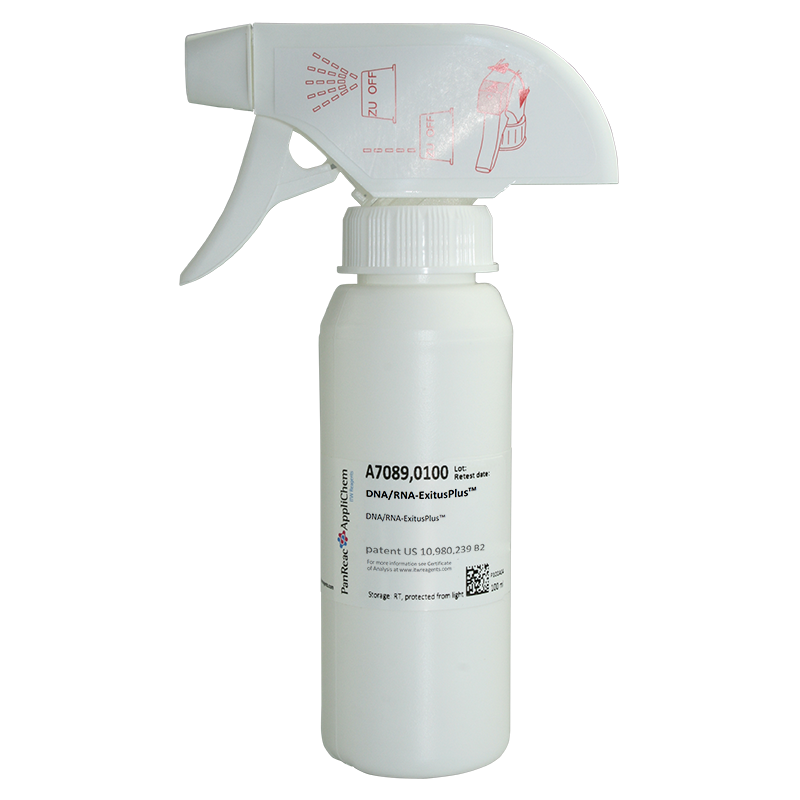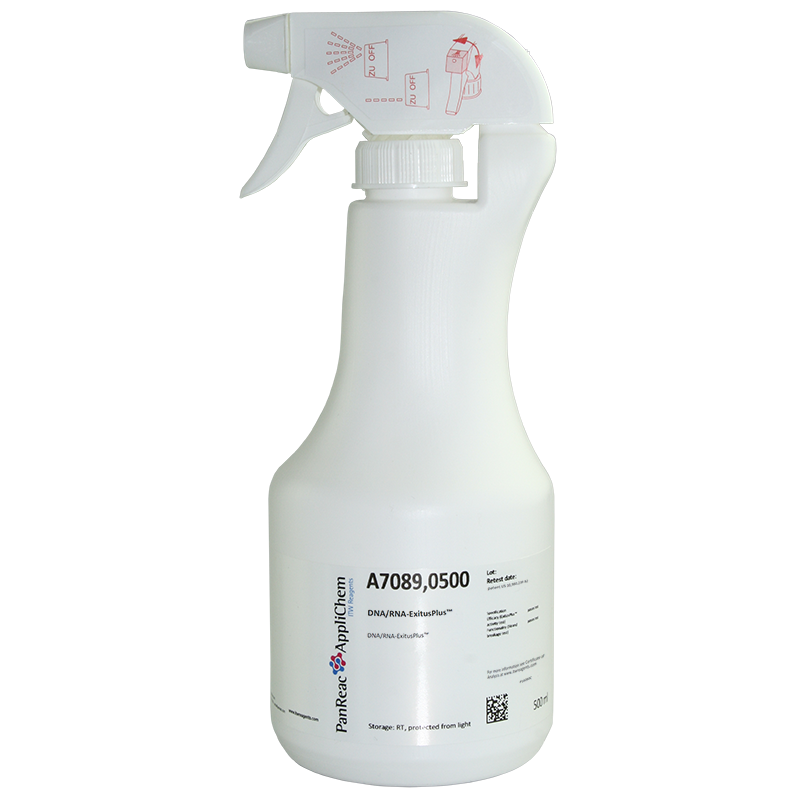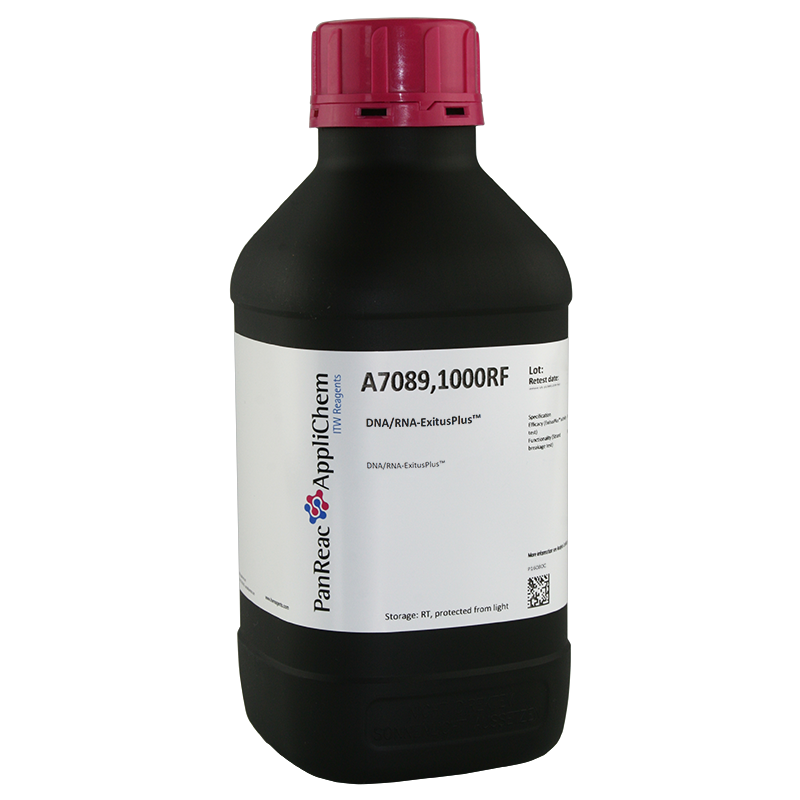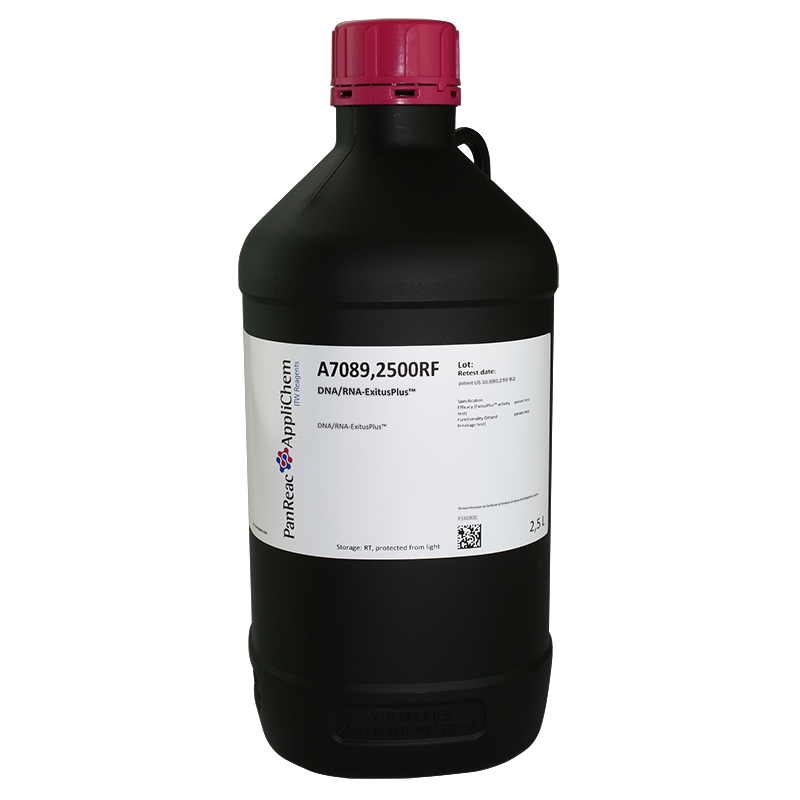Packs sizes (4)
| code | packaging size | price per unit | box price per unit | |
|---|---|---|---|---|
| Code & packaging | Price per piece | |||

|
code
A7089,0100
|
packaging size
100 ml
|
price per unit
single
39,50€
|
box price per unit
33,58€x 6 units
|

|
code
A7089,0500
|
packaging size
500 ml
|
price per unit
single
67,40€
|
box price per unit
57,29€x 6 units
|

|
code
A7089,1000RF
|
packaging size
1 L
|
price per unit
single
119,60€
|
box price per unit
101,66€x 6 units
|

|
code
A7089,2500RF
|
packaging size
2.5 L
|
price per unit
single
261,90€
|
box price per unit
222,61€x 4 units
|
Technical data
- Product Code:
- A7089
- Product Name:
- DNA/RNA-ExitusPlus™
- Specifications:
- • removes DNA and RNA contaminations from surfaces
• for cleaning of PCR work stations and equipment
• for cleaning of electrophoresis equipment, pipetts, reaction tubes etc.
• delivered as spray bottles or as refill bottles (RF)
♦ The special features
• non-enzymatic degradation of DNA and RNA by catalytic and cooperative effects of the components
• All components of DNA-ExitusPlus™ are readily biologically degradable and not harmful or toxic for humans.
• Doesn't contain aggressive mineralic acids or alkaline substances
• No toxic fumes. Contains low concentration of alcohol.
Functionality (Strand breakage test): passes test
Efficacy (ExitusPlus™ activity test): passes test
- WGK:
- 1
- Storage:
- RT
protected from light
- CS:
- 38221900
Documents
Inquiry
Comments
Application:Accidental carry-over of DNA and RNA can falsify analytical results and potentially compromise biosafety. To ensure safe workflow and accurate PCR analysis, thorough DNA/RNA decontamination of surfaces and equipment is essential.
Description:
DNA/RNA-ExitusPlus™ is a fast and effective ready-to-use agent for laboratory surfaces and equipment. Decontamination begins immediately after spraying onto a contaminated surface. Conventional DNA/RNA contamination solutions do not completely degrade DNA/RNA, but only alter it to the extent that amplification is no longer possible. DNA/RNA-ExitusPlus™, on the other hand, destroys the DNA on a variety of surfaces much more effectively, by means of non-enzymatic degradation of nucleic acids, making amplification by polymerase chain reaction (PCR) no longer feasible. Even short incubation times of 10-20 minutes with DNA/RNA-ExitusPlus™ completely remove unwanted DNA and RNA from work surfaces and equipment (1, 2). The advantage of the product is that it is neither toxic to humans nor corrosive to laboratory materials. In addition, the reagent has a shelf life of at least 12 months and is heat stable. Competing products use agents that are harmful to health and corrosive.
DNA/RNA-ExitusPlus™ is available in two different versions: DNA/RNA-ExitusPlus™ (A7089) contains a colour indicator to make the surface covered with the reagent easily visible. The indicator-free version DNA/RNA-ExitusPlus™ IF (A7409) is almost colourless. Both solutions darken over time due to the redox active components present in the solutions.
Note: There are no differences in the application protocols of DNA/RNA-ExitusPlus™ and DNA/RNA-ExitusPlus™ IF! Therefore, we do not mention the IF form in the following instructions for use. Most pack sizes are supplied with spray gun, except RF = 'ReFill' (refill) bottle, without spray attachment.
FAQs
What is the recommended contact time?
For contamination with small amounts of DNA, immediate decontamination is possible. For very large contaminations, 5 to 10 minutes at room temperature is sufficient. For larger amounts of DNA, it is recommended to repeat the procedure after wiping off DNA/RNA-ExitusPlus™.In addition, increasing the temperature of the solution to 50 °C or 60 °C significantly increases the rate of DNA degradation.
Do any methods exist for detecting residuals of the component materials of DNA/RNA-ExitusPlusTM?
The formulation of DNA/RNA-ExitusPlusTM contains a low amount of color indicator that can be detected on surfaces after drying. In case any small residual traces of DNA/RNA-ExitusPlusTM have to be removed, they can easily be wiped off the surfaces with filter paper soaked in sterile water.For inactivation of larger residual amounts of DNA/RNA-ExitusPlusTM the surfaces can be treated with a solution of sterile 10X TE buffer, pH 8.0. Make sure to prevent new contaminations during this treatment.
Are seals damaged by DNA/RNA-ExitusPlus™?
Polypropylene, stainless steel, ethylene-propylene-diene rubber (EPDM) and silicone seals are not damaged by DNA/RNA-ExitusPlus™.What is the procedure for removing residues of DNA/RNA ExitusPlusTM?
The solution can be easily washed off with sterile water or 10X TE buffer, pH 8.0.What is the procedure for removing dried-up residues of DNA/RNA ExitusPlusTM?
Dried DNA/RNA-ExitusPlus™.residues on the surfaces can be easily removed by washing once with the same solutions and wiping the solution with clean paper towels.What is the best way to remove residual DNA/RNA-ExitusPlus™ from thin tubes?
DNA/RNA-ExitusPlus™ has the advantage over other commercial products, especially for small diameter tubes, that the ionic strength of all components is much lower than other commercial products. In addition, all components of DNA/RNA-ExitusPlus™ are highly soluble in water and change the viscosity of water only slightly. In addition, they all have a very low affinity to metal or plastic surfaces.For this reason, even with very small diameter tubes, one rinsing step with 10X TE buffer, pH 8.0, and a final rinse with sterile water is sufficient for complete removal of DNA/RNA-ExitusPlus™.As a final check, determine the pH of the sterile water after the final rinse. A pH value between 6 and 8 is acceptable. Please check the pH of the sterile water before use. Caution: Sterile water prepared with anion exchangers may have a low pH value.
How can sequence-unspecific DNA be degraded?
Nucleic acids are degraded quickly and effectively with PanReac AppliChem's patented DNA/RNA ExitusPlus™ solutions. The approach is not based on an enzymatic but on a chemical principle. The sequence and size of the DNA fragments have no influence on the fragmentation. Large DNA species, such as plasmids, take longer to be completely degraded than short DNA molecules (e.g., primers). The distribution of single and double strand breaks over the entire sequence is random, so that no sequence and no homogeneous class of DNA fragments is created.What are the side effects of nucleic acid decontaminants?
Most of the common DNA decontamination methods contain strong compounds with proven corrosive, dangerous or even toxic properties. Azides, mineral acids such as phosphoric acid or hydrochloric acid, aggressive peroxides, and strongly alkaline substances such as sodium hydroxide are still used as ingredients. This often results in considerable irreversible corrosion of various metal surfaces after only 20 minutes of exposure. DNA/RNA-ExitusPlus™ has confirmed in tests that the newly developed, patented composition and mode of action shows no signs of corrosion or deterioration on metal surfaces.Does autoclaving alone provide 100% sufficient decontamination?
Most experts agree that autoclaving is a reliable method for removing DNA. For a long time, it was assumed that autoclaving generally preserved 20-30 base pair fragments. However, more recent studies show that individual larger DNA fragments can still be found after autoclaving by PCR analysis [1]. This is especially true if the nucleic acids are contained in microbes or viruses that are protected by a protein envelope (e.g., bacteria). Autoclave-ExitusPlus™ was developed because DNA/RNA-ExitusPlus™ is not heat-sensitive due to its chemical composition and does not contain any volatile compounds that are hazardous to health. For the purpose of DNA degradation, this powder mixture is applied to culture media or cell cultures. The effectiveness of Autoclave-ExitusPlus™ on bacterial cultures and nucleic acids after autoclaving has been demonstrated in tests. It has been shown that the addition of Autoclave-ExitusPlus™ is necessary to cause effective destruction of bacterial DNA; otherwise, the reference sample will always give a positive result when tested with medium or water as usual. Therefore, the effectiveness of autoclaving in extracting DNA from microbes needs to be reconsidered. Recent findings indicate that autoclaving alone does not sufficiently inactivate the nucleic acids of bacteria and viruses.How effectively does DNA/RNA-ExitusPlus™ work?
Spraying laboratory surfaces with DNA/RNA-ExitusPlus™ provides effective and complete DNA decontamination. Unwanted DNA and RNA parts are quickly removed from instruments and work surfaces after a short incubation period. The reaction time of DNA/RNA-ExitusPlus™ corresponds to the usual drying time (10 - 20 minutes).What is an effective method for disinfecting surfaces and instruments in the work area?
Proof of the effectiveness of nucleic acid decontamination agents can only be provided by means of a PCR test and a combined DNA degradation test. Past studies have confirmed the effectiveness of DNA/RNA-ExitusPlus™. DNA/RNA-ExitusPlus™ contains additional components that degrade nucleic acids gently, non-corrosively and quickly without the use of enzymes. After only a short incubation period, unwanted DNA and RNA components are removed from equipment and work surfaces.What is the decontamination process with DNA/RNA-ExitusPlus™?
Step 1: Decontamination begins immediately. In case of very heavy contamination, a longer incubation time of maximum 10 minutes is sufficient. After incubation, the residues of DNA/RNA-ExitusPlus™ are wiped off with a paper towel. Additional cleaning with sterile water is no longer necessary afterwards. This is a novelty compared to conventional decontamination solutions.Step 2: After the solution has dried completely, no further decontamination reaction takes place.
Step 3: To remove unwanted dried reagent residues, we recommend removing them with sterile water or 10X TE buffer and a paper towel.
How can a laboratory surface be decontaminated?
Apply DNA/RNA-ExitusPlus™ directly to the laboratory surface. Thoroughly wipe off the residues of DNA/RNA-ExitusPlus™ with a paper towel (remove dried residues with sterile water / 10X TE buffer). It is not necessary to rinse with water.How can laboratory equipment be decontaminated?
Apply DNA/RNA-ExitusPlus™ generously to a paper towel and thoroughly wipe all exposed surfaces of the unit. Then dry the surface with a clean paper towel. For cleaning small parts, dip them briefly in DNA/RNA-ExitusPlus™ and dry.How can plastic and glass containers be decontaminated?
Add generous amounts of DNA/RNA-ExitusPlus™ to coat the entire surface of the tube by swirling or vortexing. Discard the solution and dry. Then rinse the vessels thoroughly with distilled water and dry.How should pipettes be decontaminated?
Disassemble the shaft from the pipette according to the manufacturer's instructions and remove the seals and gaskets from the shaft. Soak the shaft in DNA/RNA-ExitusPlus™ for one minute, rinse thoroughly with water, allow to dry and reassemble.What is the shelf life of the decontaminant?
The reagent has a shelf life of at least 12 months and is heat stableWhat is the assessment of the effectiveness of the decontamination?The effectiveness of the decontamination is determined by means of quantitative examination of the DNA degradation. These tests are performed by analytical agarose gel electrophoresis or PCR tests.
If DNA is incubated with DNA/RNA-ExitusPlus™ or another decontamination reagent and a sample of the reaction mixture is placed on an agarose gel without prior neutralization or denaturation, a quantitative determination of DNA degradation is not possible because so-called "sticky ends" are formed by hybridization.
Most reagents from other suppliers contain high concentrations of strong acids and bases and must therefore be neutralized with 100 mM Tris pH 12 or 100 mM Tris pH 3, depending on the composition of the decontamination reagent, to ensure functionality (correct color) of bromophenol blue. In the case of DNA/RNA-ExitusPlus™, the buffering capacity of the loading buffer is sufficient to buffer even with a 1:1 mixture of decontamination reagent and sample.
When neutralization with bromophenol blue indicates the correct pH, the samples are denatured at 90 °C for 2 minutes.
The investigation of the potential for DNA degradation of selected conventional DNA decontamination reagents compared to DNA/RNA-ExitusPlus™ showed that a very rapid and almost complete DNA degradation by DNA/RNA-ExitusPlus™ already occurs after three minutes. Only residual DNA fragments smaller than 500 base pairs could be detected. After longer incubation (10 min), the complete plasmid DNA could also be destroyed here. In comparison, the competitor products could only show a very low degradation of the test DNA.What does PCR mean?
PCR stands for polymerase chain reaction. PCR is very commonly used in bioanalytics to first amplify DNA fragments and subsequently detect them. The importance of PCR has increased in the wake of COVID-19, as the PCR test is considered the gold standard of COVID-19 detection. Alternative DNA ZAP™?
DNA ExitusPlus™ is a DNA ZAP™ alternative. DNA ExitusPlus™ is patented, biodegradable, non-toxic, non-corrosive, quick and ready-to-use. Decontaminate your surfaces and equipment from DNA and RNA traces by using DNA ExitusPlus™. Alternative Roti® Nucleic Acid Free?
DNA ExitusPlus™ is a Roti® Nucleic Acid Free alternative. DNA ExitusPlus™ is patented, biodegradable, non-toxic, non-corrosive, quick and ready-to-use. Decontaminate your surfaces and equipment from DNA and RNA traces by using DNA ExitusPlus™. Alternative DNA Away®?
DNA ExitusPlus™ is a DNA Away® alternative. DNA ExitusPlus™ is patented, biodegradable, non-toxic, non-corrosive, quick and ready-to-use. Decontaminate your surfaces and equipment from DNA and RNA traces by using DNA ExitusPlus™. Alternative DNA remover?
DNA ExitusPlus™ is a DNA remover alternative. DNA ExitusPlus™ is patented, biodegradable, non-toxic, non-corrosive, quick and ready-to-use. Decontaminate your surfaces and equipment from DNA and RNA traces by using DNA ExitusPlus™. Alternative bleach?
DNA ExitusPlus™ is a bleach alternative. DNA ExitusPlus™ is patented, biodegradable, non-toxic, non-corrosive, quick and ready-to-use. Decontaminate your surfaces and equipment from DNA and RNA traces by using DNA ExitusPlus™. Alternative Clorox?
DNA ExitusPlus™ is a Clorox alternative. DNA ExitusPlus™ is patented, biodegradable, non-toxic, non-corrosive, quick and ready-to-use. Decontaminate your surfaces and equipment from DNA and RNA traces by using DNA ExitusPlus™. DNA ZAP™ alternative?
DNA ExitusPlus™ is an alternative for DNA ZAP™. DNA ExitusPlus™ is patented, biodegradable, non-toxic, non-corrosive, quick and ready-to-use. Decontaminate your surfaces and equipment from DNA and RNA traces by using DNA ExitusPlus™. Roti® Nucleic Acid Free alternative?
DNA ExitusPlus™ is an alternative for Roti® Nucleic Acid Free. DNA ExitusPlus™ is patented, biodegradable, non-toxic, non-corrosive, quick and ready-to-use. Decontaminate your surfaces and equipment from DNA and RNA traces by using DNA ExitusPlus™. DNA Away alternative?
DNA ExitusPlus™ is an alternative for DNA Away®. DNA ExitusPlus™ is patented, biodegradable, non-toxic, non-corrosive, quick and ready-to-use. Decontaminate your surfaces and equipment from DNA and RNA traces by using DNA ExitusPlus™. DNA remover alternative?
DNA ExitusPlus™ is an alternative for DNA remover. DNA ExitusPlus™ is patented, biodegradable, non-toxic, non-corrosive, quick and ready-to-use. Decontaminate your surfaces and equipment from DNA and RNA traces by using DNA ExitusPlus™. Bleach alternative?
DNA ExitusPlus™ is an alternative for bleach. DNA ExitusPlus™ is patented, biodegradable, non-toxic, non-corrosive, quick and ready-to-use. Decontaminate your surfaces and equipment from DNA and RNA traces by using DNA ExitusPlus™. Clorox alternative?
DNA ExitusPlus™ is an alternative for Clorox. DNA ExitusPlus™ is patented, biodegradable, non-toxic, non-corrosive, quick and ready-to-use. Decontaminate your surfaces and equipment from DNA and RNA traces by using DNA ExitusPlus™.
If DNA is incubated with DNA/RNA-ExitusPlus™ or another decontamination reagent and a sample of the reaction mixture is placed on an agarose gel without prior neutralization or denaturation, a quantitative determination of DNA degradation is not possible because so-called "sticky ends" are formed by hybridization.
Most reagents from other suppliers contain high concentrations of strong acids and bases and must therefore be neutralized with 100 mM Tris pH 12 or 100 mM Tris pH 3, depending on the composition of the decontamination reagent, to ensure functionality (correct color) of bromophenol blue. In the case of DNA/RNA-ExitusPlus™, the buffering capacity of the loading buffer is sufficient to buffer even with a 1:1 mixture of decontamination reagent and sample.
When neutralization with bromophenol blue indicates the correct pH, the samples are denatured at 90 °C for 2 minutes.
The investigation of the potential for DNA degradation of selected conventional DNA decontamination reagents compared to DNA/RNA-ExitusPlus™ showed that a very rapid and almost complete DNA degradation by DNA/RNA-ExitusPlus™ already occurs after three minutes. Only residual DNA fragments smaller than 500 base pairs could be detected. After longer incubation (10 min), the complete plasmid DNA could also be destroyed here. In comparison, the competitor products could only show a very low degradation of the test DNA.








